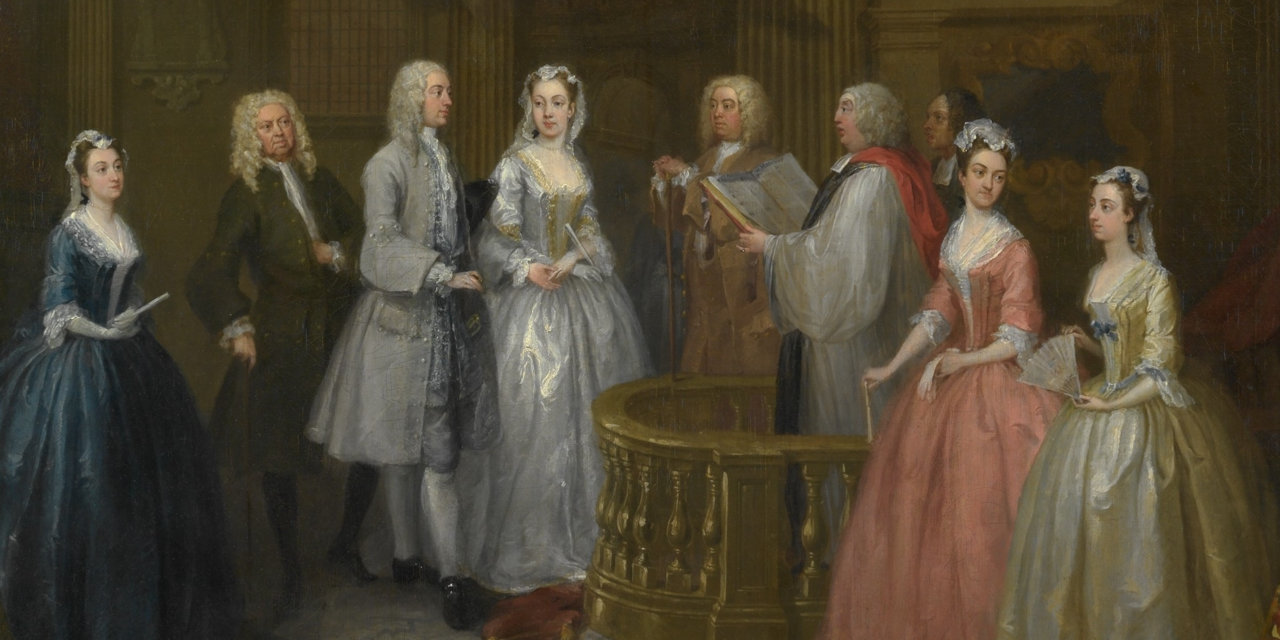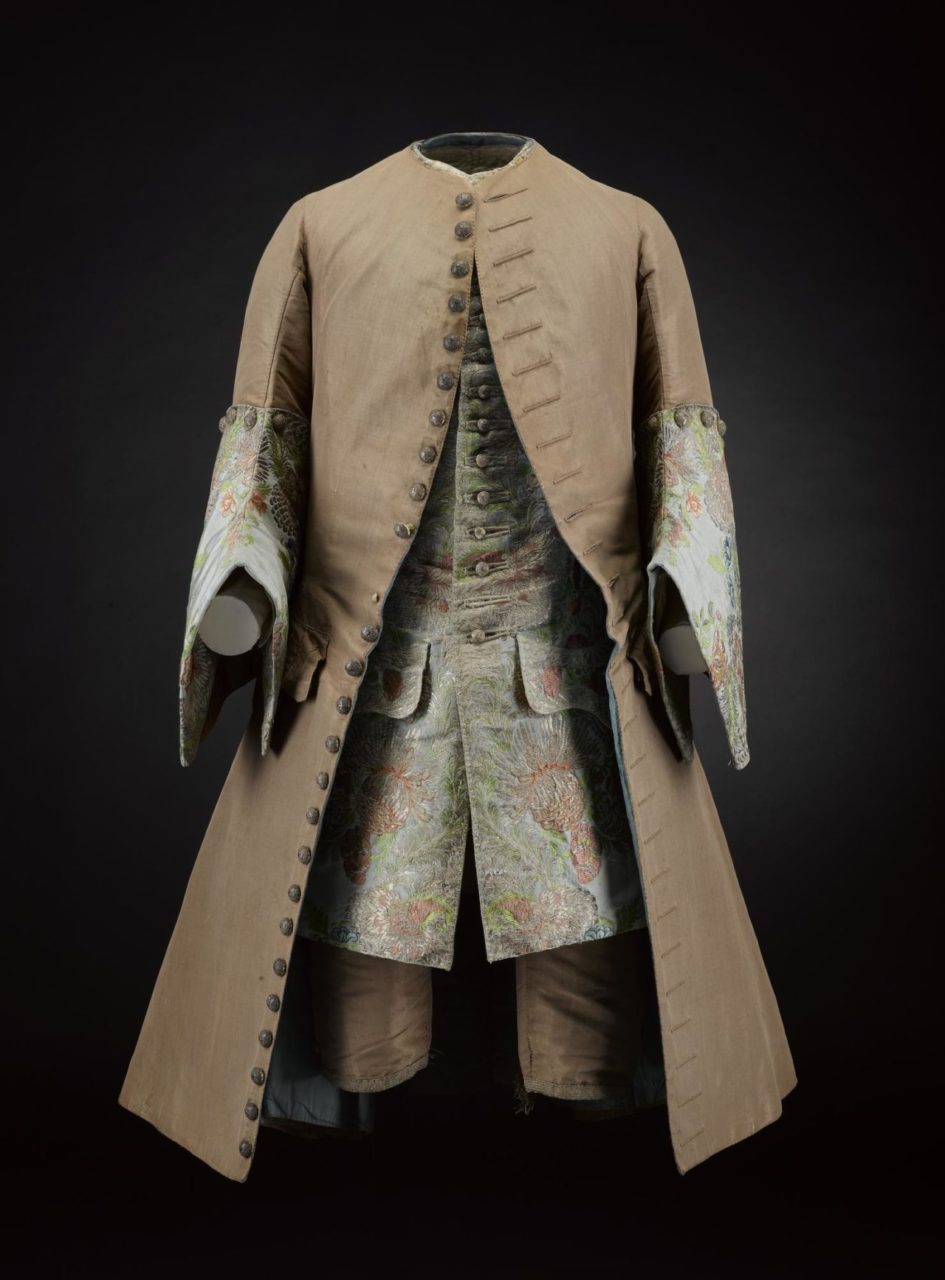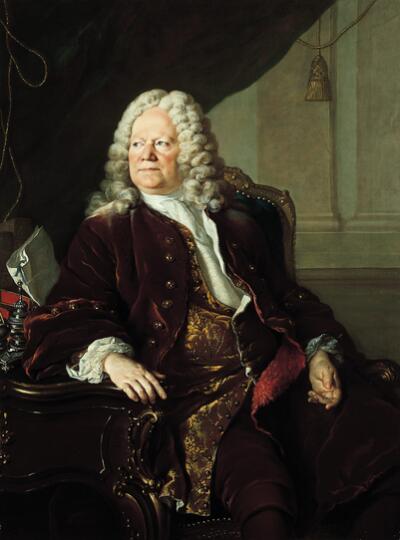William Hogarth, though known for satire, was often commissioned for portraits and conversation pieces. The Wedding of Stephen Beckingham and Mary Cox was one of his larger portraits, featuring an intimate wedding and contemporary clothing of the time.
About the Portrait
William Hogarth was an English artist born in St Bartholomew’s Close, London in 1697. Formally trained in engraving, Hogarth was particularly known for his satirical sketches and engravings.
As historian Sheila O’Connell notes, Hogarth, while technically skilled in painting through self-teaching, did not gain financial success for his commissioned portraits, as his style was not fashionable during the early 18th century (Grove Art Online). The Wedding of Stephen Beckingham and Mary Cox was created in the middle of his career.
According to the Metropolitan Museum of Art, the group depicted include a small wedding party surrounding the groom and bride, Stephen Beckingham and Mary Cox, respectively. Stephen Beckingham, was at the time, a barrister of Lincoln’s Inn in London and would later become a justice of the peace. Mary Cox was the daughter of of a lawyer and businessman. Those around them are not definitively identified, but may have included the groom’s parents and the bride’s father.
William Hogarth (British, 1697-1764), The Wedding of Stephen Beckingham and Mary Cox, 1729. Oil on canvas; 128.3 x 102.9 cm. New York: The Metropolitan Museum of Art, 1936. 36.111. Marquand Fund. Source: The Met

About the Fashion
T
he women are wearing floor-length robes à l’anglaise that cinch at the natural waist. The full effect of this silhouette can be seen in the garment in figure 1. Considering the relative status of both families, the dresses are most likely silk; similarly to the dress in figure 5, the emphasis is on the quality of the fabrics. Their accessories include stomachers, lace fichus, fans, and lace headpieces.
The men are wearing jackets, breeches, and hose. The jackets are knee-length and, as was typical for the period, possess a flare at the natural waist; the jackets may have been made of silk or wool. This silhouette and material of choice can be seen in great detail in figure 2. The men’s accessories include powdered wigs, cravats, ornamental canes and square-toed shoes.
What is interesting to note is that, despite their wealth, neither are royalty or otherwise high in social status. The wedding party’s fashionability is explored in Valerie Steele’s Paris Fashion: A Cultural History (1998), in which Steele explains that fashion was no longer solely trickling down from the French royal court but was instead made more accessible to those of wealth (14). This is how a wealthy but non-aristocratic British family was able to attain their fashion-forward wedding garments.
Weddings at the time were not public events. As such, this painting was displayed in the home of the bride and groom as a conversation piece.
The ideal figure for women of the early 18th century featured a thin waist, sloping shoulder and hips emphasized by use of panniers. The ideal figure for men was one of simplicity, with an emphasis on tailoring.
The men and women within the portrait, perhaps due to their relatively high status, are wearing dress more often seen during the 1730s, denoting an interest in being fashion forward. In general, womenswear in western Europe was starting to become innovative and was often seen as modern as fashion began to spread faster throughout the continent, as explored in McNeil’s Berg Encyclopedia of World Dress and Fashion: West Europe (35).
The style of tailoring and simplicity favored in menswear trends of the time are also seen in figure 4, which is from ca. 1737. The emphasis is on the fit and richness of fabric over any extraneous ornamentation.
A dress similar to the ones worn by the female guests of the wedding can be seen in figure 5, which is from ca. 1737, nearly a full decade later. As with the other examples explored, the emphasis is on fit and fabric over any ornamentation.
Both the men and women of the wedding portrait are dressed very typically for the period, often nearly identical to other portraits in terms of styling. The diagram below shows a close up of the wedding guests, highlighting key items that were typical for the era.
Fig. 1 - Designer unknown (British). Woman's dress and Petticoat (Robe à la française), ca. 1745. Silk plain weave. Los Angeles: Los Angeles County Museum of Art, M.2007.211.927a-b. Purchased with funds provided by Suzanne A. Saperstein and Michael and Ellen Michelson, with additional funding from the Costume Council, the Edgerton Foundation, Gail and Gerald Oppenheimer, Maureen H. Shapiro, Grace Tsao, and Lenore and Richard Wayne. Source: LACMA
Fig. 2 - Designer unknown (British). Man's coat, ca. 1735. Brown corded silk and metal thread. Edinburgh: National Museum of Scotland, A.1978.417. Source: National Museums Scotland
Fig. 3 - British (English) School. A Lady in a Red dress, 18th century. Oil on canvas; 129 x 105.5 cm. Falmouth: Falmouth Art Gallery, FAMAG:1000.38. Source: Art UK
Fig. 4 - Louis Tocqué (French, 1696-1772). Portrait of Alexis Piron (?), 1737. Oil on canvas; 128.3 x 96.5 cm (50.5 x 38 in). Pasadena: Norton Simon Art, M.1982.6.2.P. Source: Norton Simon
Fig. 5 - Jeremiah Davison (British, 1695–1745). Elizabeth Knight, 1737. Oil on canvas; 125 x 99 cm. 564. On loan from Richard Knight. Source: Chawton House Library
References:
- Cox, Caroline. “Wigs.” In The Berg Companion to Fashion, edited by Valerie Steele. Oxford: Bloomsbury Academic, 2010. Accessed December 02, 2016. https://www.bloomsburyfashioncentral.com/products/berg-fashion-library/encyclopedia/the-berg-companion-to-fashion/wigs.
- McNeil, Peter. “The Structure and Form of European Clothes.” In Berg Encyclopedia of World Dress and Fashion: West Europe, edited by Lise Skov, 33–38. Oxford: Berg, 2010. Accessed December 02, 2016. http://dx.doi.org/10.2752/BEWDF/EDch8008.
- O’Connell, Sheila. “Hogarth, William.” Grove Art Online. Oxford Art Online. Oxford University Press, accessed November 4, 2016, http://www.oxfordartonline.com/subscriber/article/grove/art/T038499.
- Steele, Valerie. “The Picture of Paris.” In Paris Fashion: A Cultural History, 13–40. Oxford: Berg, 1998. Accessed December 02, 2016. http://dx.doi.org/10.2752/9781847887238/PARISFASH0004.
- “William Hogarth, The Wedding of Stephen Beckingham and Mary Cox”. The Metropolitan Museum of Art, New York. Accessed November 4th, 2016. http://www.metmuseum.org/art/collection/search/436656
















